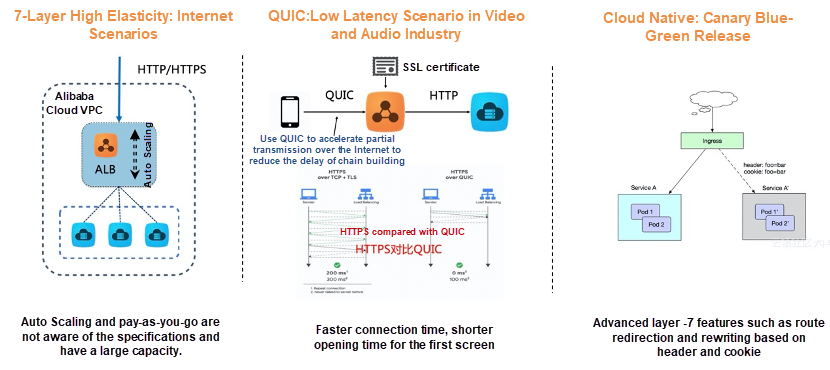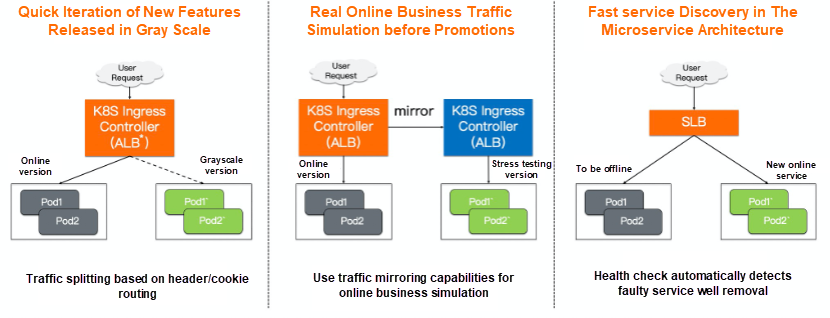Catch the replay of the Apsara Conference 2020 at this link!
Recently, Zhu Shunmin, a researcher with Alibaba Cloud Network Services, released a variety of new network products at the Apsara Conference 2020. One of the products is the Application Load Balancer (ALB.) Positioned at the application layer, ALB provides superior performance. It is secure, reliable, cloud-native, and out-of-the-box. It supports auto scaling, the Quick UDP Internet Connection (QUIC) protocol, content-based advanced routing, built-in Distributed Denial of Service (DDoS) protection, cloud-native applications, flexible billing, and other product capabilities. It meets many diversified application-layer load requirements.

When seeing the letters ALB, many people will think of the classic SLB service. Alibaba Cloud Server Load Balancer (SLB) released nearly ten years ago, providing users in various industries with powerful and stable load balancing capabilities. It distributes large amounts of concurrent traffic, prevents Single Point of Failures (SPOFs), and improves service availability. However, as enterprises and Internet businesses develop rapidly, business forms and demands are constantly changing. As a result, traditional load balancing cannot meet the requirements of many business scenarios. There is an urgent need for new product design to meet the requirements for high performance, elasticity, multi-protocol layer-7 forwarding, security, and cloud-native, such as Internet service, big e-commerce promotions, audio and video service, mobile Internet applications, gaming, financial services, and cloud-native applications.

E-commerce companies need to carry out big promotions during festivals and major events. Live broadcasting is essential, but the peak traffic volume cannot be estimated before the event. In addition, load sharing must be performed based on the region, time period, and payment process. Although traditional load balancing features unified and flexible scheduling capabilities, it still lacks elasticity, scalability, and high performance. In addition, it cannot achieve real-time elasticity, high concurrency, and large capacity. It cannot complete multi-protocol (HTTP/HTTPS/HOST/URL/Cookie/Http Method) layer-7 forwarding. A new application load balancing (ALB) product is required to meet business needs.
For various video services, such as long videos, short videos, live videos, and online education, the demand for back-end resources increases. Millions of new connection requests, automatic elastic scaling, and traffic forwarding mechanisms based on user profiles make the current layer-4 SLB unable to fully meet the business development needs. By leveraging the transmission and forwarding capabilities of QUIC, ALB can quickly establish connections, shorten latency, distribute request traffic, and ensure high-traffic services.
In recent years, many businesses have been migrated to the cloud. Cloud vendors provide unified Infrastructure as a Service (IaaS) capabilities and cloud services, which greatly improves resource reuse at the IaaS layer. Users also want to unify systems at higher layers of IaaS. In this way, resources and products can be continuously reused to further reduce the operating costs of enterprises. This is where cloud-native architecture focuses. Based on the cloud-native architecture, ALB meets user requirements in scenarios, such as phased release, traffic simulation, and microservices.

Network is critical for service migration to the cloud. As more complex enterprise applications are migrated to the cloud, the requirements for cloud networks are becoming higher. The top priority is concurrent high-traffic scheduling and application load balancing capabilities. With the launch of ALB, Alibaba Cloud will focus more on facilitating application delivery and ensuring high elasticity, security, reliability, and cost-effectiveness of applications.
Explorando la Nueva Generación de Máquinas Virtuales Con Enhanced 6th Gen ECS
Understanding Alibaba Cloud Network – New Product Launch at the Apsara Conference 2020

2,597 posts | 774 followers
FollowAlibaba Clouder - February 24, 2021
Alibaba Clouder - April 27, 2021
Alibaba Clouder - October 12, 2020
Alibaba Cloud TC Content - July 27, 2021
JDP - February 10, 2022
Alibaba Cloud Native Community - January 16, 2023

2,597 posts | 774 followers
Follow Server Load Balancer
Server Load Balancer
Respond to sudden traffic spikes and minimize response time with Server Load Balancer
Learn More Accelerated Global Networking Solution for Distance Learning
Accelerated Global Networking Solution for Distance Learning
Alibaba Cloud offers an accelerated global networking solution that makes distance learning just the same as in-class teaching.
Learn More Networking Overview
Networking Overview
Connect your business globally with our stable network anytime anywhere.
Learn More Function Compute
Function Compute
Alibaba Cloud Function Compute is a fully-managed event-driven compute service. It allows you to focus on writing and uploading code without the need to manage infrastructure such as servers.
Learn MoreMore Posts by Alibaba Clouder